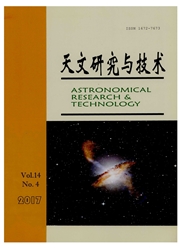

 中文摘要:
中文摘要:
使用模拟干涉成像实验对组成干涉阵列的阵元数目进行讨论,假设分别使用从20个到100个天线组成干涉阵列,使用基因遗传优化的方法得出随天线数目的增加在旁瓣水平、能量覆盖率和平均方差等3种评价标准下的性能变化曲线,通过拟合得出天线数目与各种评价效果的函数对应关系,又进一步讨论了使用效果截断、增加阵元效率等方法为设计干涉阵列的阵元数目提出合理方案,为太阳低频射电阵列阵元数目的确定提供参考。
 英文摘要:
英文摘要:
There are practical needs to recover surface brightness distributions of objects from their interferometric patterns of radio bands. Good quality of a generated image is of great importance, but usually needs to be achieved with quite a cost in instruments and operation. Radio astronomers have thus been concerned about the problem of how to obtain the best images with an interferometric array at a limited cost. Most observers with interferometric arrays set optimized numbers of array elements. The optimization of number of array elements is still an unsettled problem and this paper discusses it in details. We design simulations of synthetic-aperture imaging to help the decision of numbers of array elements. The simulated interferometric arrays constitute of antennas numbering from 20 to 100. The variations of array performances measured in SL, ECR, and RMSE are obtained by optimizing with the Genetic Algorithm, and are fit with functions. The decision of number of array element is based on methods such as effective cutoff and IAEE. From the analysis of simulations, we conclude that building antennas from $0 to 60 will be appropriate for a low-frequency solar array. Using about 50 antennas is proposed as the approach to minimize the cost. However, if the performances are to be improved, 60 or even more antennas should be used. In practice additional factors such as the budget and topography need to be considered to determine the optimized numbers of array elements.
 同期刊论文项目
同期刊论文项目
 同项目期刊论文
同项目期刊论文
 期刊信息
期刊信息
